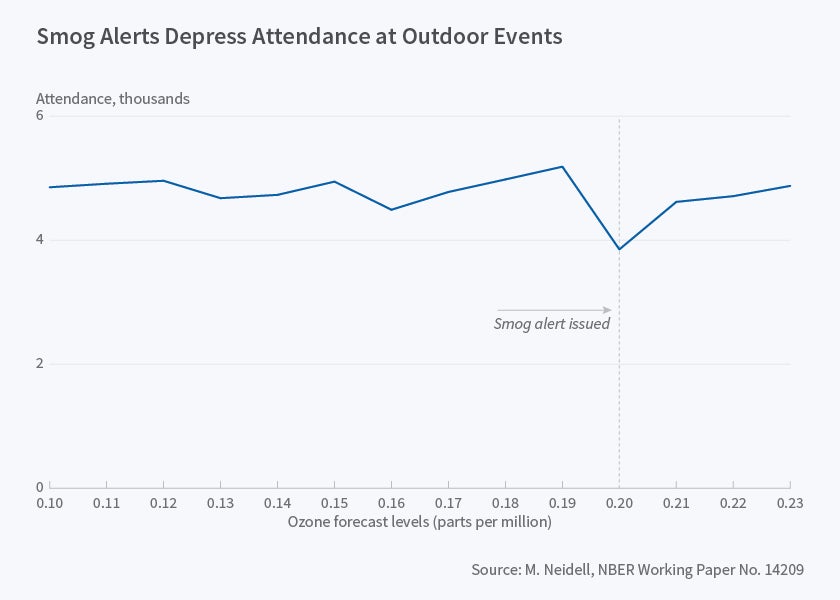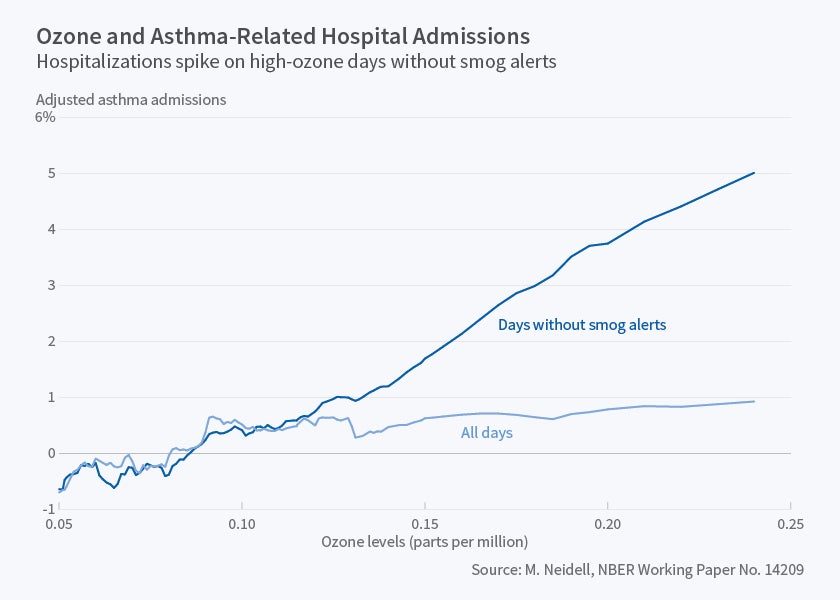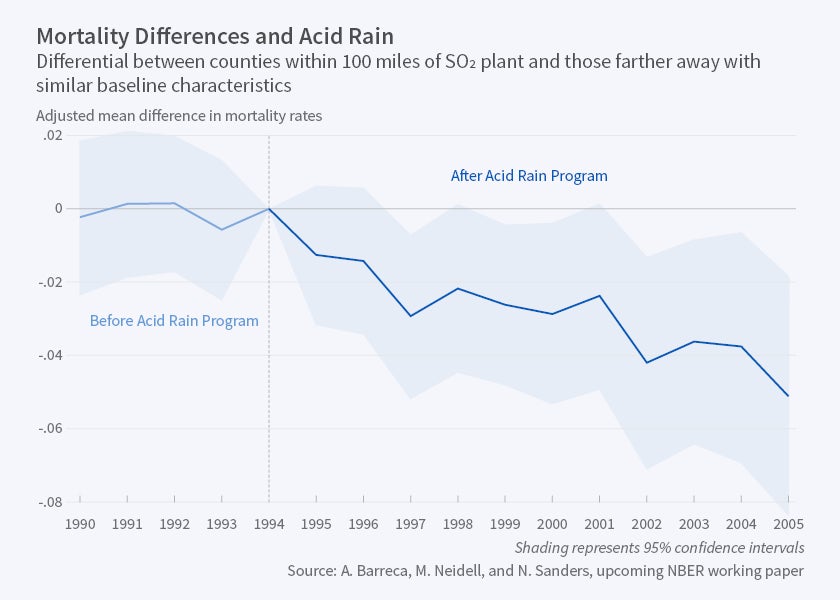The Dynamics of Air Pollution Impacts
Anthropogenic air pollution dates at least as far back as ancient Rome, and attempts to regulate it are known to have arisen as early as the 13th century. Although the nature and scale of this externality has changed dramatically since the Industrial Revolution, research on the health effects has typically been in the domain of epidemiologists and toxicologists. Economists have only recently contributed to this topic, having made several important contributions.
First, economists explicitly recognized how optimizing behavior, particularly in the form of residential sorting, can lead to endogenous pollution exposure. For example, since air quality is capitalized into housing prices, households with higher incomes may live in neighborhoods with better air quality. If these households also make other investments in their health, failing to account for them biases estimates of the effects of pollution. To address this, economists have employed a wide range of quasi-experimental techniques to provide causal estimates of the effect of pollution on health and human capital.
Second, stemming from this optimizing framework, economists have placed a considerable focus on avoidance behavior. Since the consequences of exposure to pollution are costly, individuals may engage in activities to avert them. This can bias estimates of the biological relationship between pollution and health. Furthermore, given that the activities that people engage in to avoid pollution are costly, avoidance behavior is a component of the social costs of poor environmental quality.
More recently, economic research has expanded the focus of analysis beyond traditional health outcomes to focus on a broader range of human capital outcomes, including worker productivity. Many of these impacts, particularly those where no health care services are used, are subtle and may be more pervasive throughout the economy than more extreme outcomes such as mortality and hospitalizations. If worker productivity is adversely affected by ambient pollution levels, environmental regulations that reduce these levels may increase the value of workers' human capital.
Avoidance Behavior
My early research explored whether people respond to public information about pollution by reducing time spent outside, and how these responses affect the estimated relationship between ozone and health.1 This work focused on smog alerts, which are issued when ground-level ozone is expected to exceed a particular threshold. The alerts are disseminated to encourage susceptible individuals, such as children and the elderly, to minimize time outdoors. Using originally collected data on daily attendance at two major outdoor facilities in Southern California, I explored whether people respond to smog alerts by reducing attendance at these facilities. Employing a regression discontinuity design to compare attendance on days just above versus just below the smog alert threshold to control for potential confounding, I found that there are significant declines in daily attendance on days when smog alerts are announced. This pattern is shown in Figure 1: all variables evolve smoothly with higher ozone levels, but only attendance abruptly drops when ozone reaches the value at which smog alerts are issued.
Since alerts are only issued when ozone is expected to be particularly high, failing to account for behavioral responses to the alerts can lead to an underestimation of the relationship between ozone and health. To assess this, I explored how accounting for potential responses to smog alerts affects estimates of the relationship between ozone and asthma hospitalizations. Consistent with expectations, estimates of the effect of ozone that account for smog alerts are significantly larger than estimates that do not. This relationship is depicted in Figure 2, which shows the dose-response relationship between ozone and asthma without adjusting for smog alerts (light blue line) and limiting to days without smog alerts (dark blue line).
While this paper doesn't get at the costs of avoidance behavior — it focuses on its existence and implications — a follow-on paper with Joshua Graff Zivin attempts to do so by looking at intertemporal avoidance behavior.2 In particular, responses may differ depending on how frequently alerts are issued. To assess this, we explore the impact of smog alerts issued on consecutive days on outdoor activities. Changing activities in response to alerts imposes costs on individuals since they forgo activities they would otherwise have chosen. These costs likely increase as alerts become more common, suggesting a decreased response after successive alerts. Consistent with this hypothesis, we find that responses on the second day of back-to-back alerts are considerably smaller than responses on the first day, a finding that underscores the unmeasured and potentially sizeable costs of avoidance behavior.
Worker Productivity
Focusing on more extreme outcomes, such as hospitalizations and mortality, only captures part of the full range of effects from pollution exposure. People may feel subtle insults from exposure, such as ear, nose, and throat irritation, but not require formal health care. Such effects may go undetected — possibly even by the person experiencing them — but they may represent a significant part of the total welfare effects if they are sufficiently widespread. Quantifying and valuing these subtle effects is a major challenge given the inherent difficulty in observing them.
Graff Zivin and I first confront this by focusing on the effect of pollution on worker productivity. 3 We hypothesize that workers' fatigue from these more minor insults lowers their productivity. As such, productivity can be seen as a summary measure of these insults. Studying pollution and economic output, however, introduces a simultaneity bias: because pollution is an output of industrial production, it can both cause declines in worker productivity and also be caused by increases in worker productivity. To address this issue, we collect data on worker productivity at a farm in California where workers are paid piece-rate, so we have daily measures of their productivity. We relate daily changes in pollution — which are not driven by the decisions of the farm but by the plethora of industrial activities in the region — to daily changes in productivity, holding time-invariant characteristics of the worker fixed. One advantage of focusing on these workers is that it solves the problem with avoidance behavior; since farm workers go out into the field and return at the same time, they are unable to choose their exposure. This is something we also directly test because we have measures of labor supply, and find that avoidance behavior is minimal to nonexistent in this setting. We find that increases in ozone significantly decrease productivity. Importantly, effects arise at relatively low levels of ozone where obvious health symptoms are not present in healthy populations, suggesting that we uncover more subtle effects.
While a large fraction of people around the globe is employed in agriculture, only a small fraction is in the nations with the strongest institutional capacity for regulating the environment. Tom Chang, Graff Zivin, Tal Gross, and I extend the worker-impact research to focus on the manufacturing sector, which represents a larger share of the workforce in higher income countries.4 Since workers in this sector are typically indoors, we switch focus to PM 2.5, a fine particulate pollutant that penetrates indoors. We use data from a pear factory, where workers are paid piece-rate based on the number of boxes of pears they pack. Using a similar daily level analysis as in the farm worker study, we find that higher PM 2.5 levels decrease the number of boxes workers pack. PM 2.5 also has effects on productivity at levels below air quality standards, but is not related to labor supply. Based on approximate calculations that apply these estimates to all manufacturing, the worker productivity effects represent roughly 25 percent of the total benefits, as measured by changes in housing values, from improvements in air quality, suggesting the magnitude of productivity effects is quite large.
These studies focus largely on low-skilled tasks. To explore sectors of the economy where workers have the highest value added, we study the effect of PM 2.5 on the output of call-center workers, an important part of the service sector.5 The study crosses international borders, by obtaining data from China's largest travel agency, the same one used to study the effects of working from home.6 In this setting, worker output is routinely monitored because the workers are compensated in part based on the number of phone calls completed, thus providing precise measures of each worker's daily output. As with the manufacturing study, workers are in an indoor environment where PM 2.5 is likely to be present. We find that as pollution increases, workers reduce the number of calls they place or receive, an effect largely driven by an increase in the number of breaks taken throughout the day. As with the previous studies, no effects were found for labor supply. Unlike the previous two studies, however, the effect only arose when air quality levels exceeded the current air quality standards. This difference could reflect many factors, such as the different nature of the work and/or poorer-quality measures of pollution.
The aforementioned studies omit the highest-skilled sector, where tracking of performance is most scarce. Anthony Heyes, Soodeh Saberian, and I attempt to close this gap, albeit indirectly, by investigating the effect of pollution on stock market returns.7 We hypothesize that the physiological changes induced by pollution lead to decreases in risk taking by traders, thereby lowering returns. We find that daily changes in PM 2.5 in Manhattan over a 15-year period reduce daily returns of the S&P 500, one of the most commonly used benchmarks for the overall New York Stock Exchange. Since the stocks quoted on the S&P 500 come from firms widely differentiated by activity and geography, it is unlikely that daily variations in the fundamentals that determine the fair value of those firms correlate with daily variations in air quality in the vicinity of Wall Street. As a test for this, we regress S&P 500 returns on air quality measures throughout the country, and find that only air quality in New York City matters for returns. Consistent with risk aversion as a potential explanation for this effect, we find the air pollution affects the volatility index, a commonly used measure of fear amongst traders.
Effects from Long-run Exposure
The previously discussed studies focus solely on the effects from short-run exposure. A more recent endeavor in my research aims at understanding effects of long-run exposure to pollution. As we know from the smoking literature, only after several years of smoking do health effects start materializing, and the same likely holds true for pollution. The empirical challenges for identifying the effects of long-run exposure, however, are magnified because there is more time to adjust to environmental changes. For example, most studies on the effects of short-run exposure exploit unexpected changes in pollution for which individuals have not fully compensated. As people learn about these changes over time, however, their differential responses to potential exposures raise the possibility that other health-related individual attributes may confound the measurements.
Nick Sanders, Alan Barreca, and I explore effects of long-run exposure by exploiting the Acid Rain Program, a cap and trade program that reduces sulfur dioxide and, eventually, PM 2.5.8 This program has two important features for identifying effects from long-run exposure: the drop in SO2 is a persistent shift, allowing us to observe changes in long-run pollution, and the distances that SO2 and PM 2.5 travel are vast — around 100 miles on average — so that changes in economic activity are likely subsumed by defining broad treatment areas. For example, evidence suggests plant closures affect housing prices in a radius of less than 2 miles.
Using an event study design that controls for county fixed effects, we compare the change in mortality over time in counties close to regulated SO2 plants ( 100 miles). We find that mortality differences in treatment counties decrease slowly after the introduction of the Acid Rain Program, with this relative mortality improvement growing steadily over time [Figure 3]. Since this study focuses on people age 35-64, these changes in mortality represent a significant change in life expectancy and economic productivity, which means that commonly used estimates of the value of statistical life more readily apply for valuing mortality benefits. Given the mortality effects from long-run exposure, it is plausible that avoidance behavior and worker productivity are affected by long-run exposure as well, topics worthy of future investigation.
Endnotes
M. Neidell, "Information, Avoidance Behavior, and Health: The Effect of Ozone on Asthma Hospitalizations," NBER Working Paper 14209, July 2008, and The Journal of Human Resources, 44(2), 2009, pp. 450-78.
J. Graff Zivin and M. Neidell, "Days of Haze: Environmental Information Disclosure and Intertemporal Avoidance Behavior," NBER Working Paper 14271, August 2008, and Journal of Environmental Economics and Management, 58(2), 2009.
J. Graff Zivin and M. Neidell, "The Impact of Pollution on Worker Productivity," NBER Working Paper 17004, April 2011, and American Economic Review, 102(7), 2012, pp. 3652-73.
T. Chang, J. Graff Zivin, T. Gross, and M. Neidell, "Particulate Pollution and the Productivity of Pear Packers," NBER Working Paper 19944, February 2014, and American Economic Journal: Economic Policy, 8(3), 2016, pp. 141-69.
T. Chang, J. Graff Zivin, T. Gross, and M. Neidell, "The Effect of Pollution on Worker Productivity: Evidence from Call-Center Workers in China," NBER Working Paper 22328, June 2016.
N. Bloom, J. Liang, J. Roberts, and Z. Ying, "Does Working from Home Work? Evidence from a Chinese Experiment," NBER Working Paper 18871, March 2013, and The Quarterly Journal of Economics, 130(1), 2015, pp. 165-218.
A. Heyes, M. Neidell, and S. Saberian, "The Effect of Air Pollution on Investor Behavior: Evidence from the S&P 500," NBER Working Paper 22753, October 2016.
A. Barreca, M. Neidell, and N. Sanders, "Long-Run Pollution Exposure and Adult Mortality: Evidence from the Acid Rain Program," NBER Working Paper 23524, June 2017.





